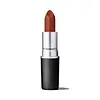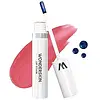What's inside
What's inside
 Key Ingredients
Key Ingredients

 Benefits
Benefits

 Concerns
Concerns

 Ingredients Side-by-side
Ingredients Side-by-side

Ricinus Communis Seed Oil
MaskingTrioctyldodecyl Citrate
EmollientGlyceryl Triacetyl Hydroxystearate
EmollientEuphorbia Cerifera Wax
Octyldodecanol
EmollientSilica
AbrasiveSimmondsia Chinensis Seed Oil
EmollientSesamum Indicum Seed Oil
EmollientOzokerite
Emulsion StabilisingCopernicia Cerifera Wax
Cetyl Ricinoleate
EmollientMicrocrystalline Wax
Emulsion StabilisingTocopherol
AntioxidantAscorbyl Palmitate
AntioxidantVanillin
MaskingAlumina
AbrasiveTin Oxide
AbrasiveCalcium Aluminum Borosilicate
Calcium Sodium Borosilicate
Mica
Cosmetic ColorantCI 77891
Cosmetic ColorantIron Oxides
CI 77163
Cosmetic ColorantCI 42090
Cosmetic ColorantCI 75470
Cosmetic ColorantCI 15850
Cosmetic ColorantCI 45380
Cosmetic ColorantCI 45410
Cosmetic ColorantCI 73360
Cosmetic ColorantCI 17200
Cosmetic ColorantCI 19140
Cosmetic ColorantCI 15985
Cosmetic ColorantCI 47005
Cosmetic ColorantRicinus Communis Seed Oil, Trioctyldodecyl Citrate, Glyceryl Triacetyl Hydroxystearate, Euphorbia Cerifera Wax, Octyldodecanol, Silica, Simmondsia Chinensis Seed Oil, Sesamum Indicum Seed Oil, Ozokerite, Copernicia Cerifera Wax, Cetyl Ricinoleate, Microcrystalline Wax, Tocopherol, Ascorbyl Palmitate, Vanillin, Alumina, Tin Oxide, Calcium Aluminum Borosilicate, Calcium Sodium Borosilicate, Mica, CI 77891, Iron Oxides, CI 77163, CI 42090, CI 75470, CI 15850, CI 45380, CI 45410, CI 73360, CI 17200, CI 19140, CI 15985, CI 47005
Water
Skin ConditioningPentylene Glycol
Skin ConditioningButylene Glycol
HumectantMica
Cosmetic ColorantAlgin
MaskingGlycerin
HumectantIndigofera Tinctoria Leaf Extract
Skin ConditioningCeramide AP
Skin Conditioning1,2-Hexanediol
Skin ConditioningCaprylyl Glycol
EmollientHydroxyethyl Acrylate/Sodium Acryloyldimethyl Taurate Copolymer
Emulsion StabilisingSqualane
EmollientCaprylyl Glucoside
CleansingAroma
Polysorbate 80
EmulsifyingTin Oxide
AbrasiveLactic Acid
BufferingGlucose
HumectantCI 77891
Cosmetic ColorantCI 45380
Cosmetic ColorantCI 42090
Cosmetic ColorantCI 16035
Cosmetic ColorantCI 19140
Cosmetic ColorantCI 17200
Cosmetic ColorantWater, Pentylene Glycol, Butylene Glycol, Mica, Algin, Glycerin, Indigofera Tinctoria Leaf Extract, Ceramide AP, 1,2-Hexanediol, Caprylyl Glycol, Hydroxyethyl Acrylate/Sodium Acryloyldimethyl Taurate Copolymer, Squalane, Caprylyl Glucoside, Aroma, Polysorbate 80, Tin Oxide, Lactic Acid, Glucose, CI 77891, CI 45380, CI 42090, CI 16035, CI 19140, CI 17200
 Reviews
Reviews

Ingredients Explained
These ingredients are found in both products.
Ingredients higher up in an ingredient list are typically present in a larger amount.
Ci 17200 is a synthetic reddish-purple dye.
CI 19140 is also known as Tartrazine. Tartrazine is a synthetic dye used in cosmetics, foods, and medicine to add a yellow color.
Tartrazine is created from petroleum and is water-soluble.
Some people may experience allergies from this dye, especially asthmatics and those with an aspirin intolerance.
Learn more about CI 19140Ci 42090 is a synthetic dye created from petroleum. It is used to give a bright blue color to cosmetics, medicine, and food.
Ci 45380 is a synthetic dye that comes from coal or tar sources. Due to this, it is often used in small quantities.
A common name for this dye is Red 22. Red 22 imparts a warm reddish color.
Similar to Red 27, this dye changes color based on pH and moisture levels.
This dye is colorless when dry but turns pink between pH levels 0.0 to ~3.0.
Learn more about CI 45380Ci 77891 is a white pigment from Titanium dioxide. It is naturally found in minerals such as rutile and ilmenite.
It's main function is to add a white color to cosmetics. It can also be mixed with other colors to create different shades.
Ci 77891 is commonly found in sunscreens due to its ability to block UV rays.
Learn more about CI 77891Mica is a naturally occurring mineral used to add shimmer and color in cosmetics. It can also help improve the texture of a product or give it an opaque, white/silver color.
Serecite is the name for very fine but ragged grains of mica.
This ingredient is often coated with metal oxides like titanium dioxide. Trace amounts of heavy metals may be found in mica, but these metals are not harmful in our personal products.
Mica has been used since prehistoric times throughout the world. Ancient Egyptian, Indian, Greek, Roman, Aztec, and Chinese civilizations have used mica.
Learn more about MicaTin Oxide is an inorganic oxide used to add opacity and volume to a product. In nature, it is already found in mineral form. The main ore of tin is an opaque and shiny mineral called casseterite.
Tin Oxide helps remove translucency in a product, or make it more opaque. Besides adding opacity, tin oxide is used for bulking to add volume.